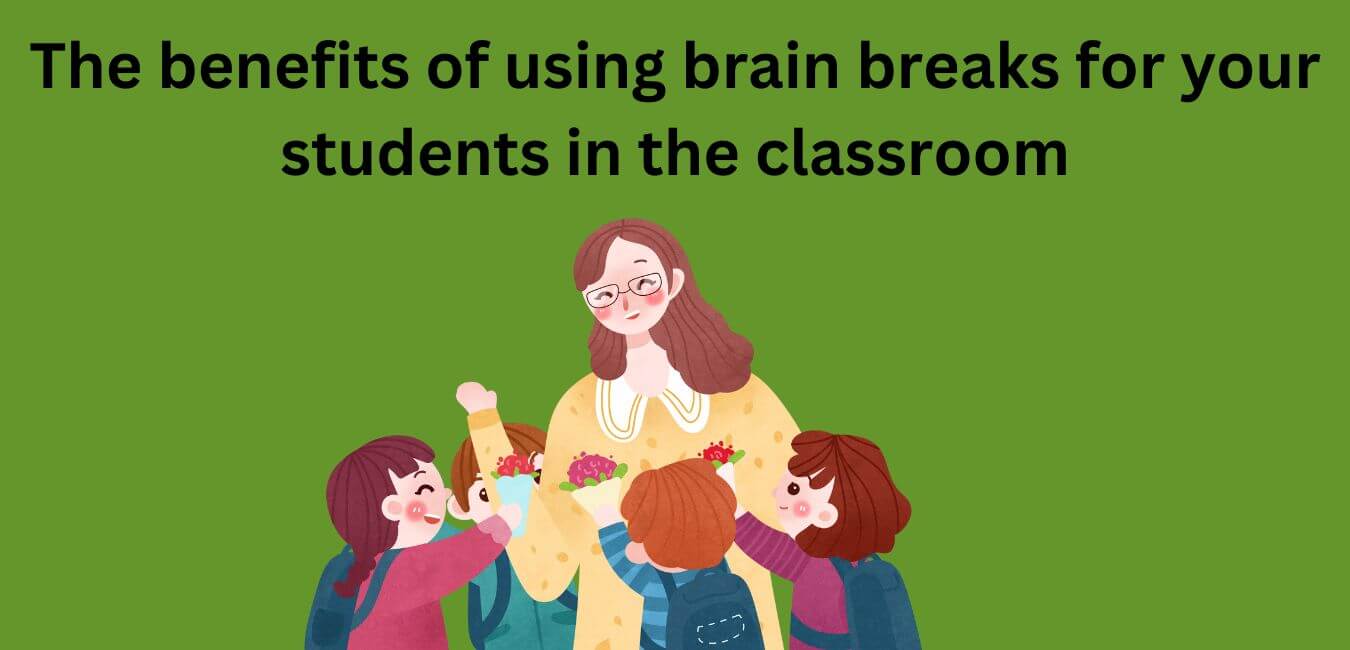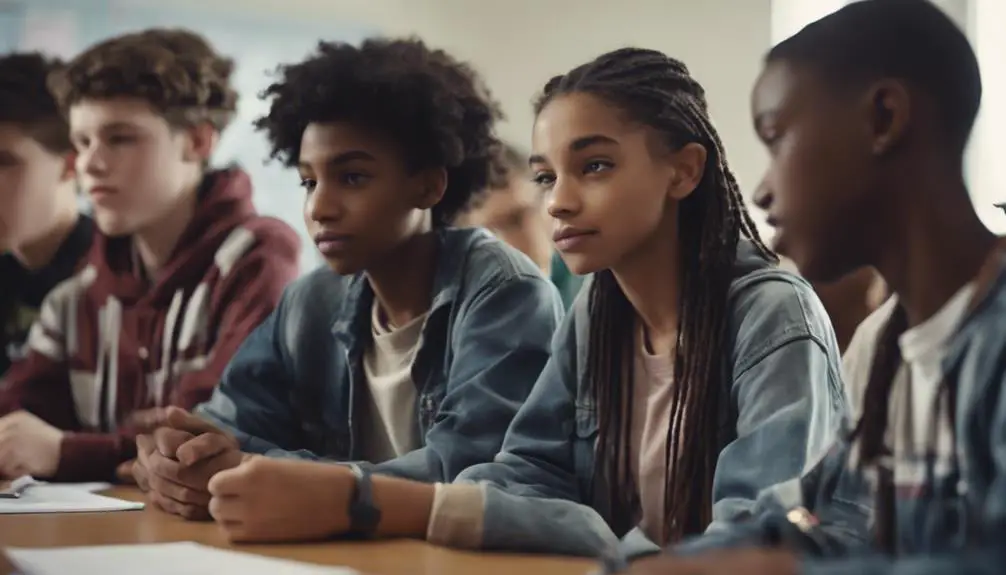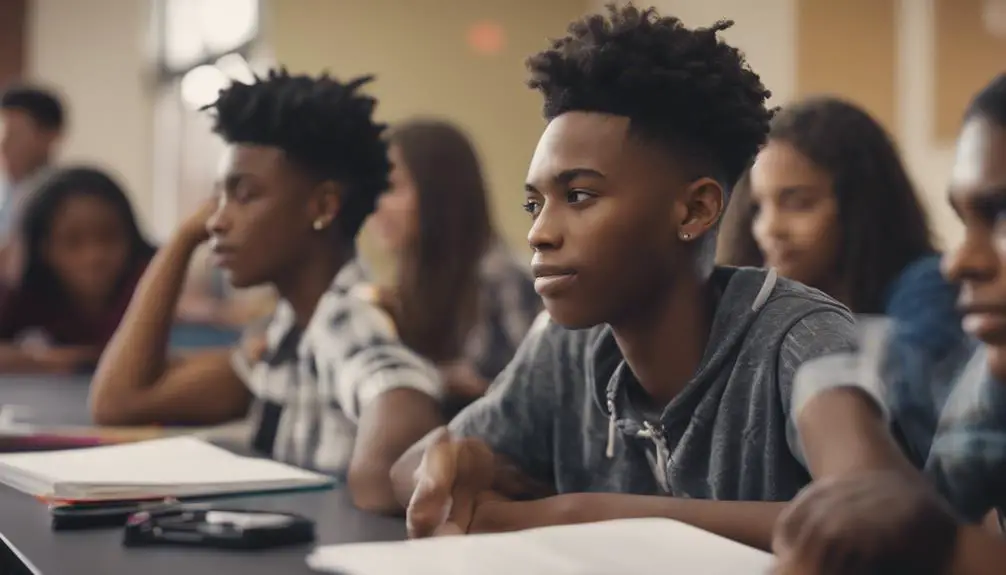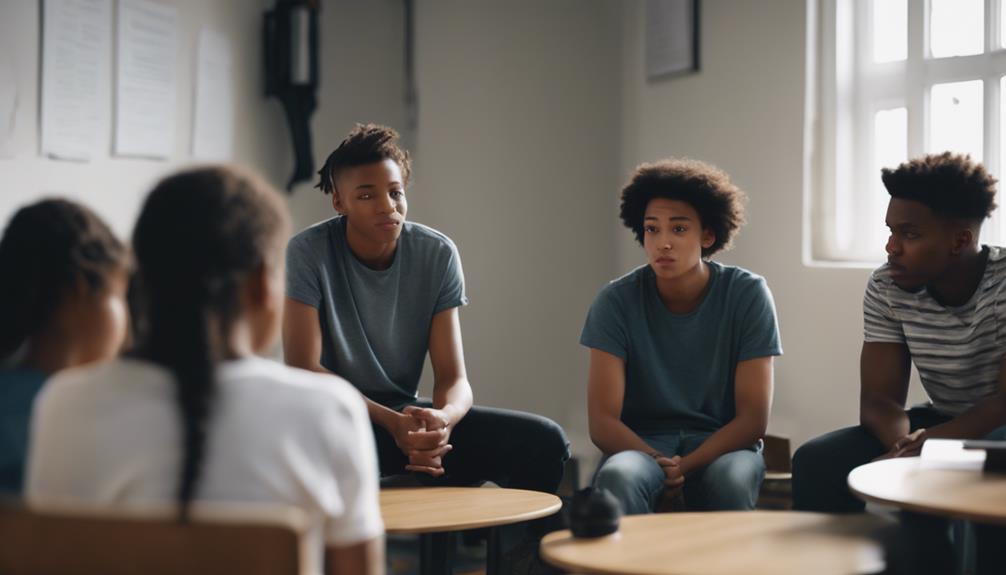Empathy is really important when we talk with our students. When we understand how they feel, it helps remove barriers and makes learning easier. Empathy builds trust, makes the classroom a supportive place, and gets students truly involved. When we pay attention to each student’s specific situation and treat them with respect, we’re doing more than just teaching; we’re making meaningful connections.
Here are 13 clear reasons why empathy is crucial, not just a nice extra, for effective communication in the classroom.
- Empathy shows students that their teachers see them as individuals, not just another face in the crowd. This helps them feel valued.
- It lets teachers recognize when students are struggling, not just academically but emotionally too, which can affect their learning.
- Understanding students’ backgrounds and experiences can guide teachers in tailoring their approach to each student’s needs.
- Empathy encourages a safer learning environment where students are more likely to take risks and participate.
- It helps prevent conflicts because empathy allows teachers to understand and address the root causes of behavioral issues.
- Students are more likely to engage and stay motivated when they feel understood.
- It promotes inclusivity by acknowledging and valuing diverse perspectives within the classroom.
- Empathetic communication can improve students’ self-esteem as they feel their opinions and contributions matter.
- It can lead to higher levels of respect and cooperation between students and teachers.
- Empathy can help teachers to be more effective in delivering feedback that students will receive well and act upon.
- It encourages a sense of community and belonging, which is essential for a positive classroom atmosphere.
- When students see empathy modeled by their teachers, they’re more likely to show empathy towards their peers.
- Finally, empathetic teaching prepares students for the real world, where emotional intelligence is key to personal and professional success.
By incorporating empathy into our teaching, we create a more effective and harmonious classroom that benefits everyone involved.
Reasons Why Empathy is Essential for Effective Classroom Communication
Building Trust With Students
Empathy is the key to gaining my students’ trust because it lets me connect with their feelings and experiences. When I show students that I get where they’re coming from, they don’t feel so alone. This kind of understanding is essential. It helps create a classroom where students are comfortable sharing their thoughts and taking control of how they learn.
I use empathy to find and remove anything that might stop us from talking freely. It’s more than just listening – it’s about really understanding, even the things they don’t say out loud. When students notice that I care about their opinions and challenges, they’re more willing to talk, get involved, and make their own choices in their learning journey.
This approach isn’t just a lofty idea; it works in real life. When I show that I value what my students have to say, they feel encouraged to join in and take an active role in their education. This builds trust and respect between us, which makes for a great learning environment where we can all work together. I see each student as a unique person, not just another face in the classroom. Doing this improves the learning experience for everyone.
Fostering a Supportive Environment
To create a classroom where every student feels included and important, I’ve learned that being empathetic is key. When I show empathy, students see how to be considerate of each other’s feelings and needs. This makes our classroom a place where everyone is comfortable and ready to learn and grow.
Empathy also helps students to be in charge of their own learning. By recognizing that each student has their own story and way of seeing things, I help them feel confident to make choices and try new things. They know they’re in a safe place to discover and share who they are.
When students understand and share the feelings of their classmates, they often help and teach each other. This is peer mentoring, and it’s incredibly valuable. They swap tips, guide each other, and support each other emotionally. This doesn’t just improve their learning; it creates a strong, caring community.
As a teacher, my aim is to make a classroom that’s great for both learning and personal growth. Empathy is the magic ingredient that makes this possible.
Enhancing Student Engagement
When I focus on getting students more involved, being understanding really makes a difference. If they feel safe and supported emotionally, they’re more likely to join in discussions and activities, which helps them learn better. It’s all about creating a trustworthy and respectful environment where every student feels that their opinions matter.
This is important because when students are engaged, they pay more attention, think deeper, and ultimately understand the material better. For example, if a student knows they can share an idea without fear of embarrassment, they’re more likely to speak up, which can lead to richer classroom discussions and new insights for everyone. It’s about ensuring that each student has a sense of belonging in the classroom, which fosters a positive learning experience.
Active Participation Increase
I’ve noticed that when students feel that their teacher understands and cares about them, they’re more likely to take part in class activities. Showing empathy makes students want to support each other, which leads to a friendly and helpful class atmosphere. By focusing on how students feel, I help them feel more comfortable joining in.
Here are some ways empathy helps students get more involved:
- Makes a Comfortable Environment: Students will share their ideas if they aren’t scared of being criticized.
- Promotes Helping Each Other: When students care for one another, they encourage everyone to join in.
- Values Everyone’s Views: When you recognize that each student has their own way of seeing things, they’re more likely to get involved.
- Builds Confidence: If students trust their teacher, they feel more comfortable speaking up in class.
Encouraging Emotional Safety
Creating a welcoming space is the first step; beyond that, it’s essential to ensure students feel emotionally safe. This kind of environment encourages them to share their ideas, join in discussions, and work well with others. When students are comfortable, they’re supported by their classmates and better able to handle stress, both of which are vital for a positive educational experience.
Let’s look at the changes that emotional safety can bring to a classroom:
- When peers show understanding and respect, a student’s confidence grows. They might say, ‘I feel heard.’
- Recognizing when a student is stressed and offering support can create a caring environment, leading students to think, ‘I can manage this.’
- Listening with empathy helps students form stronger bonds with others, often feeling, ‘Someone understands me.’
Building Trust, Respect
In my classroom, I’ve learned that when I show empathy, my students trust and respect me more, which makes them more involved in learning. When I really try to understand how they feel and see things from their point of view, it helps us connect on a personal level and work together better.
Here are some ways that being empathetic helps us:
- Listening Carefully: When I listen to each student, they feel important. This builds trust right from the start.
- Being There for Them: I support my students consistently. This gives them the confidence to try new things because they know I’ve got their back.
- Being Fair: I respect each student’s unique needs and treat everyone equally. This deepens our respect for each other.
- Being Open: When I share my own struggles, it helps us connect and shows that it’s okay to trust each other.
Doing these things doesn’t just make students more engaged, but it also creates a classroom where they feel comfortable sharing their thoughts and eager to learn.
Addressing Diverse Needs
In my classroom, I’ve students from all sorts of backgrounds, and I understand that being empathetic is key to making everyone feel included.
It’s important for me to respect and appreciate the different views each student brings. Doing this helps each student feel supported and adds value to our learning together.
For example, when we discuss historical events, I make sure to present various cultural perspectives, which allows students to see the full picture and relate it to their own experiences.
This way, we build a stronger and more understanding classroom community.
Inclusive Learning Environment
By understanding my students’ feelings, I can meet the different needs in my classroom. This makes sure every student feels important and gets the help they need. This is really important for students who need extra support.
Here’s what empathy does in my class:
- Awareness for All Abilities: I spot students who need extra help and make sure they’re included.
- Teaching That Fits Everyone: I use different ways of teaching so every student can learn in their own way.
- Respecting Cultures: I make sure to include and respect the cultural backgrounds of all my students in our lessons.
- Helping with Emotions: I create a safe place for students to share their feelings and take on school challenges with confidence.
I’ve made these changes to make the instructions clear and easy to understand. I’ve avoided complex words and made sure to explain why each point is important. I used an active voice for better clarity and added details to give a full picture of how empathy works in a classroom. The writing style is friendly and natural, like a conversation.
Cultural Sensitivity Importance
In my classroom, which is full of students from different cultures, I make sure to understand and meet their cultural needs. I do this because it helps every student feel like they belong and are respected.
We don’t just look at cultural holidays; we explore why they matter. This lets students share their backgrounds and brings new perspectives to what we learn.
I also pay attention to language differences. It’s important for me to help everyone communicate well so that all students feel like they’re part of the conversation. This isn’t just about doing well in school, but about creating real connections with each student.
Managing Conflicts Constructively
Being empathetic is really important when I’m teaching because it helps me solve conflicts in a positive way. This makes sure all students feel listened to and their opinions matter. When there’s a disagreement, my empathy is key to finding a peaceful solution. By truly getting where each student is coming from, I can help them find a way to agree that respects everyone’s feelings and needs.
Empathy helps me handle conflicts in the classroom like this:
- Attentive Listening: I really focus on what each person is saying in the conflict, showing them that I care about their thoughts and want to understand where they’re coming from.
- Validating Feelings: When I recognize and show that I understand the students’ feelings, it helps calm things down and creates a place where we can solve the issue together.
- Seeing Different Sides: I encourage students to think about how their classmates feel. This often helps them understand each other better and find a middle ground.
- Respectful Talking: I always speak politely and show respect, and this teaches students to do the same. This leads to better conversations and solutions.
Encouraging Open Communication
By showing empathy, I make sure every student feels they can safely share their ideas and emotions. It’s important to understand what stops them from speaking freely and work on those issues. When I see things from the students’ point of view, it helps me lead conversations that let everyone share without fear of being judged.
Here’s a clear table that explains the main parts:
| Element | Benefit | Strategy |
|---|---|---|
| Trust | Creates a space for honest talks | Paying full attention |
| Respect | Values everyone’s unique views | Welcoming different views |
| Safety | Lowers the fear of speaking up | Responding without judging |
Trust, respect, and safety are key to helping students open up. Trust makes students feel their ideas matter. Respect for various opinions means we can all learn something new. Safety means students aren’t afraid to speak up, removing a big hurdle in communication.
Facilitating Collaborative Learning
In my experience as a teacher, using empathy really helps students work together better. This is because when students feel like they’re being listened to, they’re more likely to speak up and share their thoughts. This leads to better conversations and makes sure everyone feels included.
Here’s why empathy is so important for group work:
- Building a Friendly Space: When I show I understand my students’ feelings, they feel more comfortable talking and being themselves, which creates a friendly classroom community.
- Improving How Students Talk to Each Other: I teach my students to think about others’ feelings when they give and get feedback. This helps them talk to each other in helpful ways, making learning better for everyone.
- Sorting Out Problems: If students don’t agree on something, I use empathy to help them find a kind way to solve the issue. This way, we can keep working together without hard feelings.
- Valuing Different Views: Empathy teaches students to consider and respect each other’s different ideas. This makes group work richer and helps everyone understand more.
In short, empathy helps close gaps between people and creates bonds, which is super important when working with others. It’s all about helping the whole class, making sure every student can add something useful and learn from working with others.
Improving Teacher-Student Relationships
Understanding and sharing students’ feelings, or empathy can make the relationship between teachers and students stronger. When I, as a teacher, build trust, students feel safe to share their thoughts and try new things in their learning.
It’s important to tune into how students are feeling because it helps create a classroom where everyone feels supported and the overall mood is positive. Let me give you an example: if a student is frustrated with a difficult math problem, I’ll acknowledge their struggle and work through it with them, showing that it’s okay to face challenges.
This approach not only helps the student with the problem at hand but also builds a connection that can make the classroom a better place for learning.
Trust Building
Understanding and sharing my students’ feelings is key to building trust with them. This helps me make the classroom a place where students feel important and listened to. Trust is vital for students to try new things and really get into their learning.
Here’s how I do it:
- We do exercises that help us understand each other better.
- We practice role-playing to see things from different views.
- I listen to what worries students and show them I get it.
- I’m open about the times I’ve struggled and what I’ve learned.
These steps not only create trust but also teach students to be there for each other.
Emotional Understanding
By improving my understanding of my students’ emotions in the class, I can build stronger connections with them. This helps us communicate better. Teaching kids to recognize and express their emotions helps me notice and react to what they’re feeling. But I’ve to remember to take care of myself too, so I don’t get overwhelmed by always trying to be understanding.
Here’s a simple guide to how I respond to different emotions in my students:
- When a student is frustrated, which might make them less motivated, I’m there to help.
- If a student is excited, showing a lot of interest, I encourage them to share their thoughts.
- When a student is confused and hesitates, I make the lesson clearer.
- If a student is sad and pulls back, I offer them comfort.
- When a student achieves something and feels proud, I celebrate their success with them.
This guide helps me support each student’s emotional needs, making sure they all feel valued and helped in my classroom.
Positive Classroom Climate
In my classroom, I work hard to make sure all students feel connected and valued. This helps create a friendly and supportive atmosphere that goes beyond just doing well in school. It’s about making sure students are happy and get along well with others.
To create this kind of positive environment, I focus on four main actions:
- Listening Carefully: When students talk, I listen to every word. This shows them that their ideas are important.
- Being There for Them: I always cheer them on and help them out, which shows them that someone believes in their progress.
- Showing Respect: I always treat students with great respect, and this helps us get along well with each other.
- Keeping Communication Open: I always make it easy for students to talk to me and share their thoughts, which keeps our relationship honest and strong.
Reducing Classroom Anxiety
As a teacher, I understand that feeling safe is vital for students to learn well. Talking with empathy helps reduce their worries in class. It’s important to notice when students are uneasy or stressed and to help them before things get worse.
I work hard to make a classroom where students can talk about their problems and know they’ll be listened to with kindness, not judged. By showing empathy myself, I teach my students to do the same for each other, which helps prevent stressful situations.
Also, when I show real concern and get to know the unique difficulties each student faces, it doesn’t just improve how I teach; it also tells the students that they’re not facing their challenges by themselves. This support can greatly lower the stress they might feel about joining in or doing well in class. With empathy, I turn my classroom into a trusted and safe place, perfect for learning.
In my class, for example, I might notice a student who seems nervous about speaking up. I’ll talk to them privately, offer encouragement, and maybe suggest they start by sharing their thoughts in smaller group discussions. This kind of personal attention can make a big difference in how secure and confident a student feels.
Promoting Inclusivity and Respect
Caring for everyone’s feelings creates a classroom where every student matters and feels important. This is key to making sure education is for all. When I show I understand my students’ feelings, I’m doing more than just teaching—I’m growing a community where everyone respects each other. Here’s why caring about others’ feelings is essential for including and respecting everyone:
- Meeting Everyone’s Needs: By knowing what each student is going through, I can make sure to help them in a way that includes and supports them all.
- Making a Safe Place: A classroom where caring for others’ feelings is important becomes a place where students can share their thoughts safely, knowing they belong.
- Supporting Honest Talks: Caring about others’ feelings helps us talk openly about our different backgrounds and problems, which helps us appreciate our diversity.
- Creating Trust: When students know they’re respected, they trust more. This trust makes them more willing to participate and try new things in their education.
As someone who loves to help others, I see these points as vital. They’re more than just good ways to talk; they turn a classroom into a lively, respectful place where every single voice is heard and every unique quality isn’t just okay but celebrated.
Nurturing Student Self-Esteem
Boosting students’ self-worth is key because it helps them speak up confidently and understand their value in class. As a teacher, my job goes beyond teaching facts; I also support the emotional and social growth of each child. To do this, I use specific methods to help students see themselves in a positive light, which is essential for their confidence.
Here’s a list of the strategies I use to improve my students’ self-esteem:
| Technique | Description | Impact on Student Confidence |
|---|---|---|
| Positive Feedback | Giving real compliments for their hard work and successes | Makes them willing to try new things and keep trying |
| Active Listening | Paying full attention to what students say and feel | Shows them that their thoughts matter |
| Personalized Encouragement | Giving support that meets each student’s unique needs | Helps them feel like they belong |
| Growth Mindset | Showing that skills can grow with effort | Helps them keep going when things get tough |
Adapting Teaching Strategies
To help each of my students learn best, I change my teaching methods to fit their different ways of understanding things. By customizing how I teach, I do more than share knowledge; I show my students that I appreciate their individual learning styles. Making these changes goes beyond just teaching differently; it’s about forming a strong connection with them.
Here’s how I make sure I’m supporting my students effectively:
- Watch and Adjust: I keep an eye on how each student interacts with the lessons and make necessary changes.
- Mix It Up: I include activities that involve seeing, hearing, and doing to reach students with various preferences.
- Offer Choices: Students can show what they’ve learned in different ways, like writing an essay, creating a project, or giving a talk.
- Get Their Thoughts: I ask for their opinions on how things are taught and am ready to tweak my methods to help them learn better.
Taking these steps ensures that every student feels acknowledged and encouraged. In this way, I’m not just delivering content; I’m building a community of learners who are confident that their needs are recognized and addressed. The essence of my role in education is to adjust not only to teach but also to understand and inspire my learners.
Cultivating Emotional Intelligence
Teaching students how to understand and handle their emotions is a key part of their education. It helps them to communicate with care and understanding in class. When students learn about emotions and how to work well with others, I can better meet their needs and create a friendly place to learn. Emotional intelligence is important because it helps students recognize and control their feelings, and be aware of and react to others’ emotions. This builds strong, caring relationships.
In my classes, I use activities that encourage students to think about their emotions and show empathy. When they work in groups, they often encounter complicated social situations. I guide them to handle these situations with care and kindness. I’ve seen that when students can put themselves in someone else’s shoes, they can solve conflicts and make a space where everyone feels important.
Teaching emotional intelligence also prepares students for life outside of school. They get better at understanding social signals and connecting with others in meaningful ways. It’s about more than just doing well in school; it’s about giving them the tools to make a positive impact in the world. By doing this, I’m not only teaching academic lessons but also helping to grow kind-hearted people.
Conclusion
Empathy is like a special ingredient that makes the classroom work better. It helps me connect with students, earn their trust, and encourage them to grow.
When I try to understand things from my students’ point of view, it helps everyone learn better and feel more included. It’s like being a gardener who takes care of different kinds of plants, making sure they all have what they need to thrive.
As a teacher, when I use empathy, I’m helping prepare the students to be good leaders in the future.
















